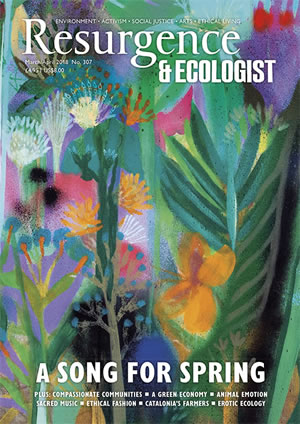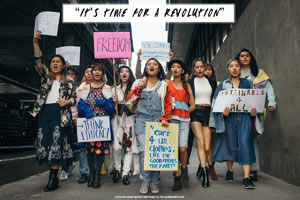On 24 April 2013 the Rana Plaza, an eight-storey building complex in Dhaka, Bangladesh housing several clothing factories, collapsed. The death toll ran to 1,135, and over 2,500 people were injured. It was one of the world’s worst industrial accidents.
In the aftermath of the disaster, outrage grew even as the dead and injured were being pulled from the wreckage. On the morning of the collapse, it soon emerged, garment workers had been scared to enter the building after noticing large cracks that had appeared in the walls overnight, but had been told by their employers to go to work or they would forfeit their salaries.
Nor was it only human casualties that were unearthed in the rubble. Clothing was recovered bearing labels associated with British high street stores – and yet the fast-fashion supply chain is so opaque it took weeks for some of those British companies to establish whether they had contracts with the factories at Rana Plaza.
Orsola de Castro was a designer with a small upcycling label called Estethica when she heard the news from Bangladesh. “I was at my home in south-west London,” she says. “My reaction was the same as many who work in the fashion sphere. My first thought was, I knew this would happen. Then, I’m bloody angry this has happened. And then I was in tears.”
A few days later she received a call from Carry Somers, the founder of Pachacuti, a fair trade hat brand, and one of Orsola’s designers, who suggested they start a grassroots campaign to raise awareness of the disaster and create more transparency in the supply chain of big fashion brands. It would be called Fashion Revolution. “It resonated with me immediately,” says de Castro. “I felt this was my next step.”
Due to public pressure in part created by Fashion Revolution, over 100 brands and retailers signed the Accord on Fire and Building Safety in Bangladesh in the aftermath of the Rana Plaza disaster. The accord commits brands to full safety inspections, and ensures their financial support for repairs and renovation.
The accord had limited initial success, however. A Transparency International Bangladesh report in 2014 showed that widespread corruption at factory level was still evident, with bribes being paid to circumvent safety rules. At the same time, compensation for those affected by the disaster trickled in slowly. The Rana Plaza Donor Trust Fund was set up to pay compensation to the survivors and victims’ families, but a year on from the disaster only half the companies connected to a factory in the building had made pledges, and the fund was just a third of the way to its US$30 million target, only reaching it another year later amid renewed public concern.
Fashion Revolution continues to remember Rana Plaza but also campaigns for transparency and workers’ rights across the world, helping the 75 million people working in the clothing manufacturing industry worldwide. Fashion Revolution Day has expanded into a week where, amongst other activities, people are encouraged to use social media to question the brands.
For the fifth anniversary of the disaster, Fashion Revolution Week (which this year falls on 23–29 April) will see the campaigning extend further into the environmental impact of the clothing industry. “We launched with a film called Loved Clothes Last about not throwing away your clothes, and we continue to grow our campaigns,” says de Castro.
The campaign is succeeding in spreading its message across the world. During last year’s Fashion Revolution Week, the hashtag #whomademyclothes appeared 355 million times in newsfeeds on social media. Offline, around 66,000 people attended some one thousand Fashion Revolution events, including catwalks and clothes swaps, film screenings, panel discussions, creative stunts and workshops.
Fashion Revolution also runs the annual Fashion Transparency Index (FTI), a review of 100 of the biggest global fashion brands, which ranks clothing companies on the transparency of their supply chains, including how much information they disclose about their suppliers, policies and practices, as well as the social and environmental impacts of their activities.
“We need to re-establish the broken connections in the supply chain,” Somers says, “because greater transparency is a prerequisite to improving conditions.”
Of the potential 100% that the clothing companies can achieve for full transparency on the Fashion Transparency Index, many brands linger around the 20% mark, with no brand scoring above 49%, according to the 2017 figures. “High-end” labels represent some of the lowest final scores, with Dior scoring 0% and Chanel just 1%.
The Swedish fashion giant H&M was one of the highest-scoring fast-fashion brands on the FTI, with a score of 48% in the 2017 ranking. None of the textile factories located in Rana Plaza was producing for the company, but it does use factories in Bangladesh. It currently shares a list of almost all its first-tier suppliers’ names and addresses and over 50% of its second-tier suppliers (fabric and yarn mills or subcontractors). H&M suppliers provide around 1.6 million jobs around the world, according to the company.
In 2013, H&M vowed to pay what it calls a “fair living wage” to the garment workers in its supply chain by 2018. In May 2017 it said this work was “at the top of our agenda”, but by November workers’ rights group Clean Clothes was questioning the company’s commitment, saying it had been “notoriously opaque” about its plans.
The Irish brand Primark scored only 24% in the 2017 index, but some efforts are being made to improve sustainability. One in three sets of women’s pyjamas bought in the UK is from Primark, and the company now makes a line of the garments with sustainable cotton, focused on its suppliers in rural India, in partnership with CottonConnect, an international organisation with its headquarters in the UK, and the India-based Self Employed Women’s Association.
“What’s particularly exciting for us is we know that this cotton has come from sustainable sources because we’ve been able to track it through our supply chain,” says Katharine Stewart, Ethical Trade and Environmental Sustainability Director at Primark. The line represents a minuscule fraction of what Primark produces, but the company says it intends to increase the sustainable cotton programme over time. “It’s a first step towards achieving our long-term goal,” says Stewart, “but a significant one.”
Despite these efforts, the fast-fashion companies must do more, de Castro says.
“These guys have money to throw around and they can upscale to sustainable solutions,” she says. “If you look at one of the most ethical brands, [outdoor clothing company] Patagonia, it is the money and size that allows them to experiment in sustainable products. What is surprising is that the rest of the luxury fashion industry doesn’t spend more on sustainable solutions.”
But even Patagonia, which represents a high-water mark for ethical clothing, has an impact on the environment and has, in a very unusual move, started encouraging its customers to buy fewer of its products. Patagonia is running a campaign to get its consumers to focus more on mending their clothing than to buy anew, with free DIY repair guides online and videos of Patagonia customers showing off their damaged clothes.
Rose Marcario, Patagonia’s chief executive, says, “Despite a deep commitment to responsible manufacturing, [Patagonia] still takes more from the earth than it returns.” She has written on the Patagonia blog about the difference between product consumers and owners. “Owners are empowered to take responsibility for their purchases – from proper cleaning to repairing, reusing and sharing. Consumers take, make, dispose and repeat – a pattern that is driving us towards ecological bankruptcy.”
“It’s about changing mindsets,” says de Castro. “Those who can afford luxury fashion need to understand that small-scale, slow fashion is true luxury.”
The trend in slow fashion – decreasing the speed of production and placing greater value and appreciation on every component of the item of clothing – has been gaining momentum for a number of years. Including the people who make the clothes is an important part of this.
“It’s about the stories for me,” says Elena Todary, founder of the London-based boutique The Collaborative Store. “We want to support and enrich the makers who put their soul and love into making products in a good and ethical way, thinking of every person in the supply chain.”
The designers and makers stocked in Todary’s store are working to much tighter margins than high street brands, but the fact that they are small and nimble allows them to start with an ethical supply chain. Todary’s collections are never ‘trend-led’; instead the focus is on designs that can be worn throughout the years.
“Through years of fast fashion, people are used to fast, cheap products, whereas we are trying to build awareness,” says Todary. “I have started to see that customers are really interested in these stories about how and where our products are made and by whom – and it makes the customer feel they have something special.”
These stories will be especially poignant on the anniversary of the Rana Plaza disaster.
“Fashion affects 100% of the population, so we can all do something,” says de Castro. “Your wardrobe is a part of the supply chain. It is between the cotton farmer and the landfill. What you wear is your choice. That, I think, is what makes Fashion Revolution so empowering.”








